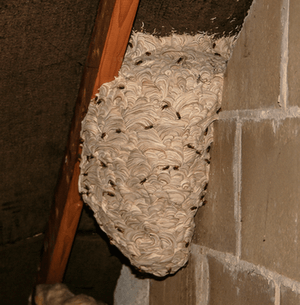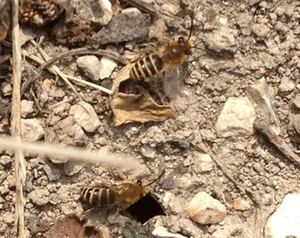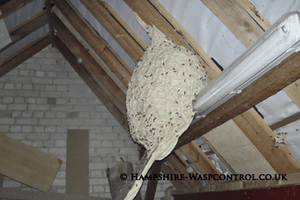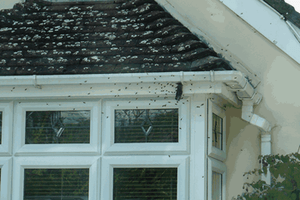Wasp nest database, your questions answered about wasps, hornets, and bees
Below are some frequently asked questions and answers, we will continue to expand this part of the website over time.
The titles to each question link to more information contained on other pages of the site.
Do wasps build nests inside houses?
Wasps tend to construct their nests inside houses, sheds, garages, and almost any place that is dry, warm, and accessible. Due to their small size, wasps can enter through even the tiniest openings. Loft spaces are their preferred choice because of their easy access and the space that a loft provides. Roof rafters are excellent starting points for building nests, and the environment is warm, dark, and relatively undisturbed. Wasps can also nest in wall cavities if there is access. They can use any space and build their nests in any shape to adapt to the environment.

Do I need to have a wasp nest removed?
It is generally not recommended to remove a wasp nest after treatment. Once the wasps inside the nest have been treated, the nest becomes a harmless piece of chewed wood. Wasps use a nest for only one season, so leaving the nest in place will prevent other wasps from building a new nest in the same spot. Old nests usually remain unused for many years before falling off and disintegrating. Therefore, we do not remove wasp nests after treatment, as it takes some time for the treatment to take full effect. Once the nest is dead, it is finished and will never be reused, so removing it is unnecessary.
If you find a nest and are still determining whether it is active, there are a few questions you can ask yourself. What time of year is it when you find the nest? If it is summer, the nest could be active, but if it is late winter, it is probably dead. If it is spring, how big is the nest? New nests in the spring are usually the size of a golf ball and no larger than an orange.
Can you see any activity on or around the nest? An active, healthy nest in the summer will always have wasps walking over the outside of the nest, and there will be a constant stream of wasps leaving and arriving at the nest. Can you hear anything? Wasps can be noisy, so you may hear scratching and popping sounds from some nests. If the weather is hot, you may hear a humming sound as the wasps fan the nest with their wings to cool it down. However, a buzzing noise is generally from bees.
If you are sure the nest is dead and want to get rid of it, the best time is late winter, when you can be confident it has finished. Suppose you have the nest treated to kill it. We recommend leaving it a day or two after treatment to allow all the wasps to return from foraging. Hence, they come into contact with the insecticide. If you need to remove a wasp nest, you can safely remove it once you have determined it is old and dead. We suggest wrapping a bin liner around as much of the nest as possible and pulling the nest into the bag, as wasp nests are fragile and can crumble easily.
Do wasps nest underground?
It is common for wasps to build their nests in the ground. They usually take over old burrows of voles, mice, or rabbits to construct their nests. Wasps dig the soil around the nest to expand the area underground for building their homes and carry the dirt away from the nest site.
You can identify a wasp nest in the ground by watching the activity around the burrow. Usually, wasps nesting underground have one or two entrances. As the nest grows with more individuals, the traffic to and from the nest will increase. Eventually, you will see wasps queuing at the entrance holes to enter or leave.
A type of bee called a mining bee burrows into the ground. Mining bees come in various colours and shades and have no sting. They only stay for a few weeks and then leave. They do not require any treatment.
Mining bees excavate individual holes that look like large wormholes. They are harmless and beneficial insects and cannot sting. You will see mining bees in the spring and Ivy bees (a type of mining bee) in late summer.
Although rare, hornets can and do nest underground. They usually take over a disused rabbit burrow or mouse hole and build their nest in an underground void they will excavate if necessary.
Hornets prefer to nest in voids in old trees or lofts, requiring a reasonably large space to build their nest. Some bee species, including bumblebees, also nest underground similarly.
Bumblebees are black, large, and fluffy, and the most common type is the whitetail bumblebee (which has a white bum). If you see bees entering a single hole in the ground, it is probably bumblebees. If you see many small holes with bees entering them, they are likely mining bees. In either case, it is best to leave them alone.
Please note that we do not treat any bees.

Why do wasps nest in lofts?
Wasps tend to build their nests in attics for a few different reasons. Firstly, attics are typically quiet, undisturbed places, which is ideal for them. Additionally, attics can get quite hot during the summer, which helps keep the young wasp larvae warm. Attics also provide plenty of space with many suitable areas for nest building. While many wooden structures in lofts are ideal for nest building, wasps don't usually chew wood from the loft structure itself for nest building material. Instead, they may chew the surrounding area of the nest to provide more space for nest expansion.

Can I destroy a wasp nest myself?
Many products are available for DIY wasp treatments. Still, we have noticed that these often fail to eradicate the nest effectively. Unfortunately, this can lead to problems when dealing with the nest after a failed attempt. If you have decided to kill the nest yourself, please don't call us afterwards.
We are in the business of wasp nest treatments, so of course, we will advise you to have a professional attend and destroy your nest. However, there are some facts that you can research for yourself regarding the dangers of wasp attacks. We do not charge exorbitant prices and are cheaper than your local council.

